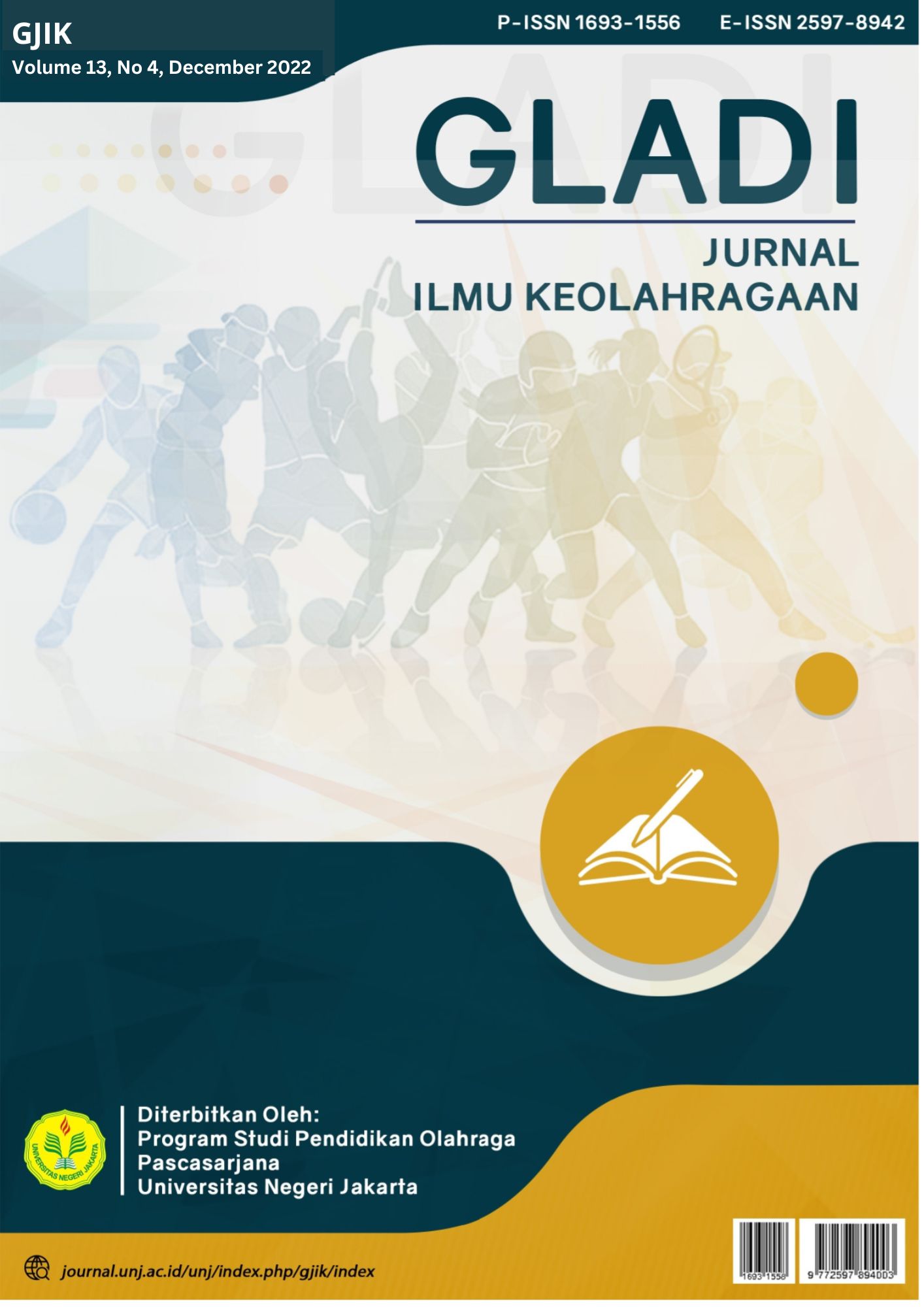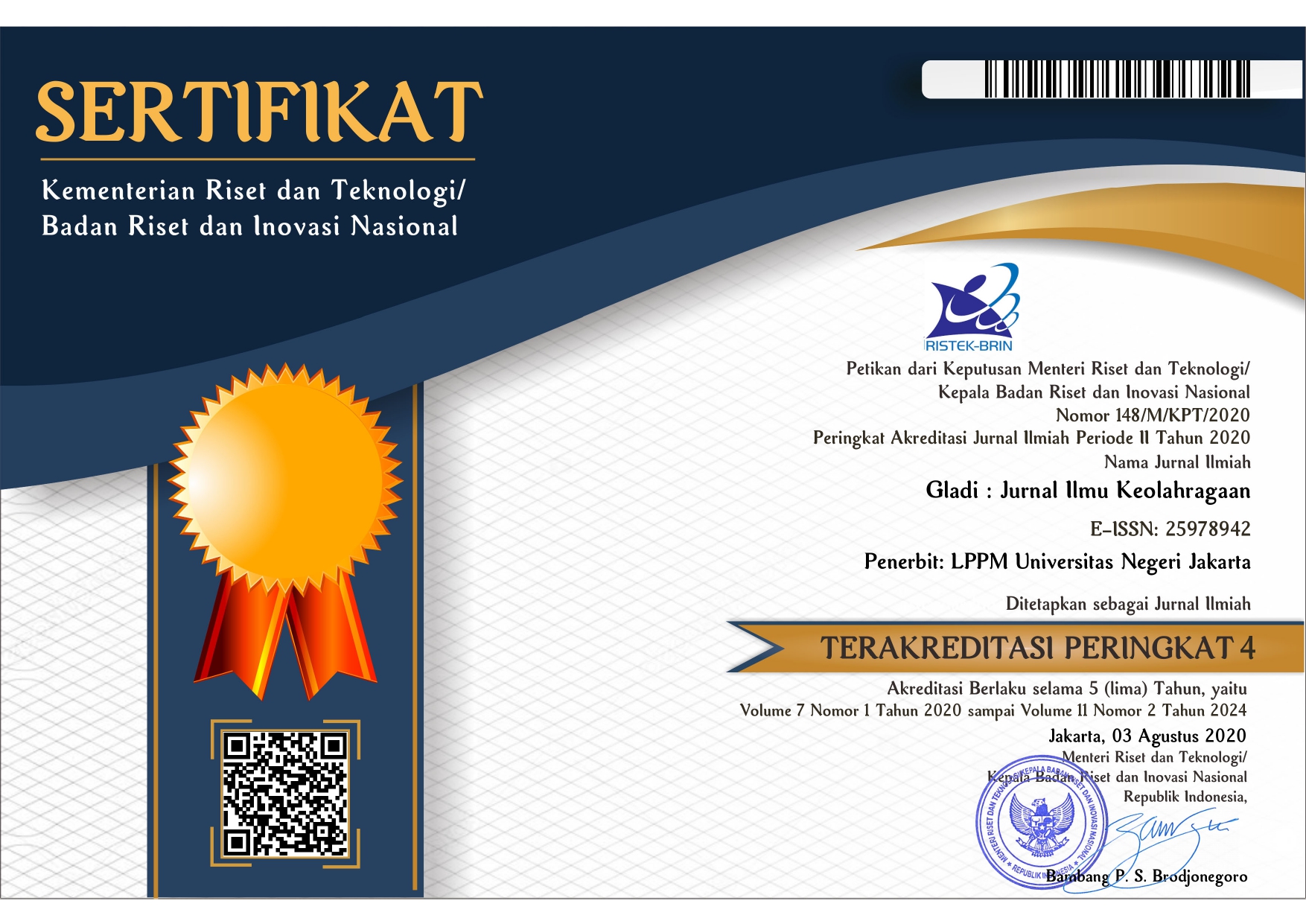The effect of flexibility, kinesthetic perception, and motivation on the skills of the 50 meter butterfly swimming
DOI:
https://doi.org/10.21009/GJIK.134.02Keywords:
flexibility; kinesthetic perception; motivation; butterfly styleAbstract
This study aims to determine the effect of flexibility, kinesthetic perception, motivation together on the learning outcomes of butterfly swimming. The method used in this study uses a quantitative approach, survey method with test and measurement techniques. The data analysis technique used a path analysis approach. The population of this research is second semester students in the physical education study program, health and recreation, FKIP-UNSIKA, Karawang Regency. There are 155 second semester students. The sampling technique used the purposive sampling method, so that the number of people studied were 31 people who met the researchers' criteria after the butterfly style swimming test was carried out. Based on statistical analysis, the results of hypothesis testing are obtained that 1) flexibility (X1) has a direct positive effect on motivation (Z) by 6.05%.2) Kinesthetic perception (X2) has a direct positive effect on motivation (Z) by 28.62%. 3) Flexibility (X1) has a direct positive effect on the 50-meter butterfly (Y) swimming of 1.85%. 4) Kinesthetic perception (X2) has a positive direct effect on the 50-meter butterfly (Y) swimming by 2.1%. 5) Flexibility (X1) and kinesthetic perception (X2) affect the learning outcomes of butterfly style swimming (Y) through the motivational intervening variable (Z) oby 58.37%
Downloads
References
Amelia, F. (2017). Semantik Konsep dan Contoh Analisis. Madani.
Aminuddin. (2008). Semantik: Pengantar Studi tentang Makna. Sinar Baru Algesindo.
Arini, A. D. (2013). Bentuk, Makna, dan Fungsi Bahasa Tulis Media Sosial sebagai Alat Komunikasi dan Interaksi pada Internet. Skriptorium, 2(1), 35–49.
Chaer, A. (2002). Pengantar Semantik Bahasa Indonesia. Rineka Cipta.
Chaer, Abdul. (2012). Linguistik Umum. Rineka Cipta.
Djajasudarma, T. F. (1993). Semantik 1 dan 2: Pemahaman Ilmu Makna. Eresco.
George, F. H. (1981). Semantics (Second Edition). Cambridge University Press.
Hunt, A., & Beglar, D. (2002). “Current research and practice in teaching vocabulary.” In J. . J. C Katz (Ed.), Semantics Theory. Harper & Row.
Keraf, G. (2010). Diksi dan Gaya Bahasa. Gramedia Pustaka Utama.
Kridalaksana, H. (2008). Kamus Linguistik Edisi Revisi. Gramedia Pustaka Utama.
Leech, G. (1981). Semantics: The Study of Meaning. Penguin Book.
Lyon, G. (1981). Semantics, Volume 1 dan 2. Cambridge University Press.
Maslakhah, S. (2013). Pengembangan Discourse Competence Guru Bahasa SMP Sedaerah Istimewa Yogyakarta. Universitas Negeri Yogyakarta.
Mulyana, S. (1964). Semantik (Ilmu Makna). Jembatan.
Pateda, M. (2010). Semantik Leksikal. Rineka Cipta.
Prawirasumantri, A. (1998). Semantik Bahasa Indonesia. Departemen Pendidikan dan Kebudayaan.
Simarmata, M. Y. (2020). Pengajaran Semantik pada Mahasiswa. Jurnal Penelitian Dan Pengembangan Sains Dan Humaniora, 4(1), 37–42.
Suhardi. (2015). Dasar-Dasar Ilmu Semantik. Ar-Ruzz Media.
Suwandi, S. (2011). Semantik: Pengantar Kajian Makna. Media Perkasa.
Tarigan, H. G. (1985). Pengajaran Semantik. Angkasa.
Ullmann, S. (2009). Pengantar Semantik. Pustaka Pelajar.
Verhaar, J. W. M. (2001). Asas-Asas Linguistik Umum. Gadjah Mada University Press.







